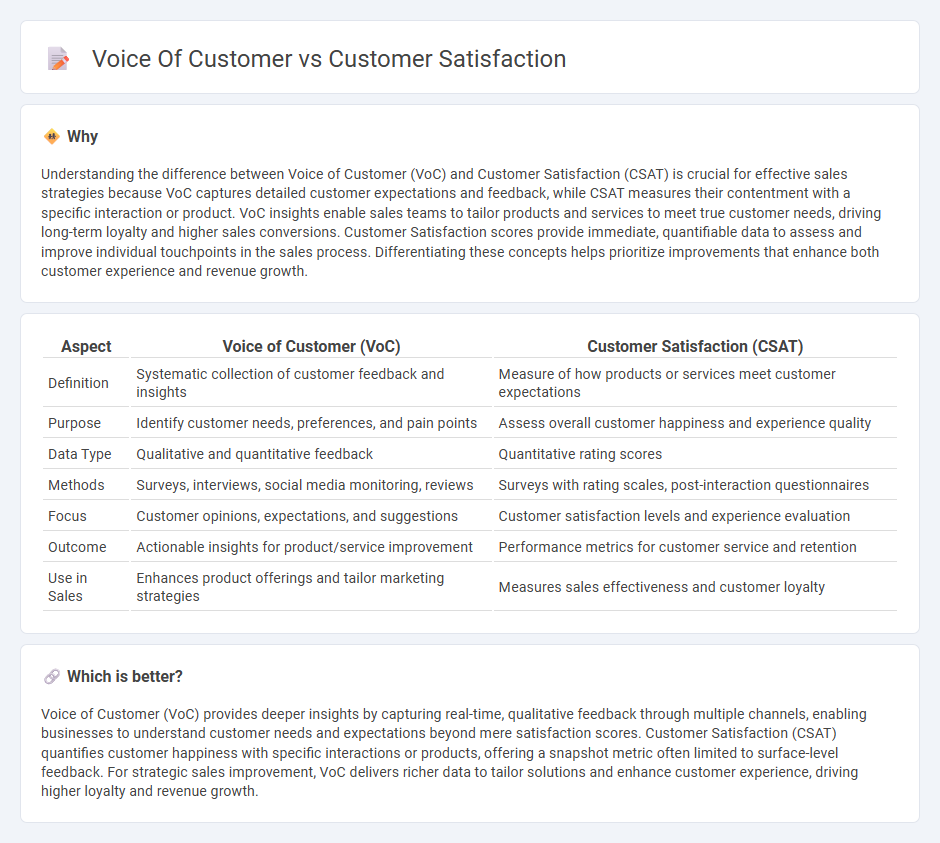
Voice of Customer captures detailed feedback and expectations directly from buyers, providing actionable insights into their needs and preferences. Customer Satisfaction measures how well products or services meet these expectations, reflecting overall happiness and loyalty. Explore how integrating Voice of Customer with Customer Satisfaction strategies can drive sales growth and improve customer retention.
Why it is important
Understanding the difference between Voice of Customer (VoC) and Customer Satisfaction (CSAT) is crucial for effective sales strategies because VoC captures detailed customer expectations and feedback, while CSAT measures their contentment with a specific interaction or product. VoC insights enable sales teams to tailor products and services to meet true customer needs, driving long-term loyalty and higher sales conversions. Customer Satisfaction scores provide immediate, quantifiable data to assess and improve individual touchpoints in the sales process. Differentiating these concepts helps prioritize improvements that enhance both customer experience and revenue growth.
Comparison Table
| Aspect | Voice of Customer (VoC) | Customer Satisfaction (CSAT) |
|---|---|---|
| Definition | Systematic collection of customer feedback and insights | Measure of how products or services meet customer expectations |
| Purpose | Identify customer needs, preferences, and pain points | Assess overall customer happiness and experience quality |
| Data Type | Qualitative and quantitative feedback | Quantitative rating scores |
| Methods | Surveys, interviews, social media monitoring, reviews | Surveys with rating scales, post-interaction questionnaires |
| Focus | Customer opinions, expectations, and suggestions | Customer satisfaction levels and experience evaluation |
| Outcome | Actionable insights for product/service improvement | Performance metrics for customer service and retention |
| Use in Sales | Enhances product offerings and tailor marketing strategies | Measures sales effectiveness and customer loyalty |
Which is better?
Voice of Customer (VoC) provides deeper insights by capturing real-time, qualitative feedback through multiple channels, enabling businesses to understand customer needs and expectations beyond mere satisfaction scores. Customer Satisfaction (CSAT) quantifies customer happiness with specific interactions or products, offering a snapshot metric often limited to surface-level feedback. For strategic sales improvement, VoC delivers richer data to tailor solutions and enhance customer experience, driving higher loyalty and revenue growth.
Connection
Voice of customer (VoC) data directly influences customer satisfaction by providing insights into customer needs, preferences, and pain points that enable sales teams to tailor their strategies effectively. High-quality VoC feedback allows businesses to identify gaps in product or service delivery, leading to improvements that boost customer satisfaction scores and loyalty. Analyzing VoC metrics such as Net Promoter Score (NPS) and Customer Effort Score (CES) helps sales organizations align offerings with customer expectations, driving increased revenue.
Key Terms
Net Promoter Score (NPS)
Customer satisfaction measures overall contentment with products or services, while Voice of Customer (VoC) captures detailed feedback, emotions, and expectations directly from customers. The Net Promoter Score (NPS) is a key VoC metric that quantifies customer loyalty by categorizing respondents into promoters, passives, and detractors based on their likelihood to recommend a brand. Explore how integrating NPS into customer experience strategies can drive business growth and improve retention.
Customer Feedback
Customer satisfaction measures how well products or services meet customer expectations through surveys and ratings, while Voice of Customer (VoC) captures detailed insights, emotions, and preferences from direct feedback channels like interviews and social media. Both tools are essential in understanding customer feedback for improving service quality and fostering loyalty but differ in scope and depth of data gathered. Explore more to leverage effective customer feedback strategies that enhance business performance.
Expectations Management
Customer satisfaction measures how well a product or service meets or exceeds customer expectations, often quantified through surveys and feedback scores, while Voice of Customer (VoC) encompasses a broader analysis of customer sentiments and needs gathered from multiple channels. Expectations management is crucial in aligning service delivery with VoC insights to prevent dissatisfaction and enhance overall customer experience. Explore how integrating VoC data with satisfaction metrics can optimize expectations management and drive business success.
Source and External Links
What Is Customer Satisfaction? - Customer satisfaction measures how well an organization meets customer expectations and is crucial for business success by reducing churn and enhancing competitive advantage through product quality, customer service, and perceived value.
What is Customer Satisfaction? - It is a measure of how happy customers are with a company's products, services, and capabilities, assessed through tools like surveys to understand and meet customer needs effectively.
How to Measure Customer Satisfaction: 4 Key Metrics - Customer satisfaction is evaluated using key metrics like overall satisfaction, which reflects emotional and rational responses to a product or service and predicts customer loyalty.
 dowidth.com
dowidth.com